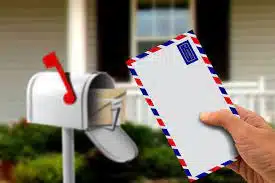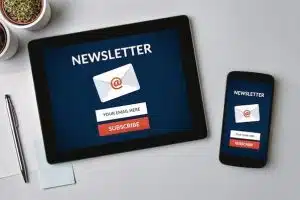Email marketing is the act of sending a commercial message, typically to a group of people, using email. Every email sent to a potential, or current customer could be considered email marketing. It simply means using email to send advertisements, request business, or solicit sales or donations.
Email marketing strategies commonly seek to achieve one or more of three primary objectives: build loyalty, trust, or brand awareness.
The term, in a broader sense, refers to sending email messages with the aim of enhancing a merchant’s relationship with current or previous customers, encouraging customer loyalty and repeat business, acquiring new customers or convincing current customers to purchase something immediately, and sharing third-party ads.
Email marketing is when you send a commercial email message to your ’email subscribers’ — contacts who have signed up to your email list and given express permission to receive email communications from you.
Email marketing is used to inform, drive sales, and build a community around your brand (e.g. with a newsletter).
Modern email marketing has moved away from one-size-fits-all mass mailings and instead focuses on consent, segmentation, and personalization.
TYPES OF EMAIL MARKETING
Email marketing can be done in several ways and via different types of emails. These can be broadly discussed in the following paragraphs;
Transactional emails
According to Wikipedia, Transactional emails are usually triggered based on a customer’s action with a company. To be qualified as transactional or relationship messages, these communications’ primary purpose must be “to facilitate, complete, or confirm a commercial transaction that the recipient has previously agreed to enter into with the sender”, along with a few other narrow definitions of transactional messaging.[3] Triggered transactional messages include dropped basket messages, password reset emails, purchase or order confirmation emails, order status emails, reorder emails, and email receipts.
The primary purpose of a transactional email is to convey information regarding the action that triggered it. But, due to their high open rates (51.3% compared to 36.6% for email newsletters), transactional emails are an opportunity to introduce or extend the email relationship with customers or subscribers, anticipate and answer questions, or cross-sell or up-sell products or services.
Many email newsletter software vendors offer transactional email support, which gives companies the ability to include promotional messages within the body of transactional emails. There are also software vendors that offer specialized transactional email marketing services, including providing targeted and personalized transactional email messages and running specific marketing campaigns (such as customer referral programs).[citation needed]
Direct emails
Direct email involves sending an email solely to communicate a promotional message (for example, a special offer or a product catalogue). Companies usually collect a list of customer or prospect email addresses to send direct promotional messages to, or they rent a list of email addresses from service companies.
The Benefits of Email Marketing
From order confirmations to newsletters, emails are an essential aspect of the growth and management of your business.
According to Sendinblue, email marketing will help fulfil three key objectives:
1. Conversions (selling your products and services)
Launching a sale or promotion? You can send an email marketing campaign to your subscribers to drive sales.
Other email marketing techniques known to increase conversion rates include:
Emailing a discount or special offer (birthday/anniversary emails, welcome emails, re-engagement emails)
Abandoned cart emails (triggered whenever a visitor abandons a cart at your online store)
2. Brand awareness
What’s great about email is that it lets you reach someone directly. It’s one-to-one communication at its best. And besides, people don’t just let anyone into their inbox these days. It’s a curated space reserved for favourite brands and publications.
Showing up in someone’s email inbox will help your brand stay top of mind. A personalized marketing email is more impactful than a social media post where you can’t be sure if someone has seen your message.
One of the significant benefits of email marketing is its scalability. This means that emails can be sent to a large number of recipients for a relatively low cost (compared to other marketing channels).
3. Customer loyalty
Email drives customer loyalty at every stage of the buyer journey: lead-nurturing, conversion, onboarding, retention.
It’s a powerful tool for building a community, as discussed at length in our guide to building relationships with email.
You can create newsletter content so good that subscribers will be waiting for it to arrive each week. Keep reading, and we’ll tell you how.
How To Get Started With Email Marketing
This definitive guide walks you through getting started with email marketing and helps you achieve business success.
STEP ONE
Establish your email marketing goals
It can be tempting to sign up for an email marketing tool like Campaign Monitor and send your first campaign. One needs to know his goals and work towards achieving them effectively.
But before starting anything, it’s worth taking a minute to think about your goals and what you want to achieve with email, as that will dictate the type of campaigns you send, who you target, the content you include, and how you measure success. This is very pivotal for your campaign.
According to Campaign Monitor, email should be an essential component of every digital marketing plan because it effectively drives conversions and builds brand loyalty.
Marketing Plan Example—Sample Marketing Plan Template
The key to establishing the correct goals for your email marketing initiative is to align them with your company’s broader marketing goals & KPIs. Is the goal to drive new signups for your product? Does New lead for your sales team? More attendees for your event? More donations for your cause?
Email marketing is the single most powerful channel to reach your audience. It can be used to achieve several different objectives, so it’s worth spending some time thinking about what you want to accomplish with it before jumping in.
To help you identify what your goals should be, here are some examples of how Campaign Monitor customers use email marketing:
BuzzFeed – The popular news and entertainment website earns revenue by selling advertisements on their site, so the key objective of their marketing team is to drive more traffic. With that in mind, BuzzFeed sends regular email newsletters containing links to stories on their website to increase the number of visits they get each month and the amount of revenue they generate.
Rip Curl – The global surfing brand generates revenue by selling wetsuits, t-shirts, boardshorts and other surfing goods. The goal of their marketing team is to increase sales, so they use email to promote new products they’re launching to try to drive people to their online or physical stores to purchase those products.
UNICEF – The global charity organization provides humanitarian aid and assistance to mothers and children in developing nations worldwide. Success to their digital marketing team is donations, so they use email marketing to reach out to their donor base, educate them on aid projects UNICEF is undertaking, and ask for assistance.
SXSW, Inc. – This lean organization organizes some of the most well-known events in the world, including the SXSW film, music and interactive festivals held every year in Austin, Texas. The goal of their marketing team is to increase ticket sales and attendees at these events, so they use email marketing to keep subscribers up to date as new artists and speakers join the lineup.
Soho House – This prestigious members-only club is a regular hangout for celebrities and media moguls worldwide. The goal of their marketing team is to keep their member base engaged in the club and regularly using the facilities, so they use email marketing to keep their members up-to-date on events and functions they can attend.
As you can see from these examples, planning what you want to achieve with email before sending makes it much easier to identify what to send and who to send it to and helps you create focused, high-performing email campaigns that will achieve your marketing goals.
STEP TWO
Build your email marketing list
Honestly, before we even start, it’s essential that you get an email marketing provider that you’re comfortable with and can help you build your email list.
This is one of the top list building strategies, but it will require a bit of homework from your side. What is important is that your email marketing provider has the following capabilities:
a variety of signup forms
the ability to send the signup to different lists
the ability to monitor the effectiveness of each signup form
the ability to segment your subscribers based on various behaviours
the ability to send automated messages based on these lists and segments
With that, you’ll have everything in place to start building your email list from scratch.
STEP THREE
Select the type of email campaigns you want to send
There are several different types of email campaigns, marketers you can send to subscribers, and the style you choose depends on your goals in STEP ONE.
Here are some of the different types of campaigns you may want to run for your business.
Newsletter
An email newsletter is a regularly distributed email campaign that is generally about one main topic of interest.
Marketing Offer
A marketing offer email is essentially any campaign you send intending to drive direct response.
This can take several different forms, including:
- A campaign showcasing some of the latest stock and encouraging people to purchase
- A campaign offering a discount or special promotion on your products or services
Announcement
An announcement campaign is an email sent to your subscribers announcing a new product, feature, or service.
A prime example of an announcement campaign is this email from Campaign Monitor customer Showtime announcing the launch of their new show Penny Dreadful.
Event Invitation
An event invitation email is a campaign designed to increase awareness of your event and encourage people to attend.
STEP FOUR
Create your first email marketing campaign
It is now time to built a bit of an audience and selected the type of campaign you’re going to send, and it’s time to start building your email.
Email tools like Campaign Monitor make it incredibly easy to create beautiful email marketing campaigns, but there are some fundamentals that you should know to make sure you get the best results from each campaign.
You may wish to check out their drag-and-drop email templates and how to edit images in the email guide. That would also help.
According to Campaign Monitor, research shows that an adult’s attention span is, on average, eight seconds. With such a short attention span, you can assume people aren’t closely reading your campaigns word for word instead of scanning through them looking for something of interest.
Writing long, text-heavy email campaigns isn’t the best approach. You need to structure your emails to help draw people into reading your content while guiding them toward the email’s call to action.
The bulk of the email is visual with minimal text. Ideally, you want to avoid walls or blocks of text. This is because visuals – both video and images – are more eye-catching.
They’re also more memorable and help content stand out.
Even in the early stages of growing your email list, it’s a good idea to categorize subscribers into different list segments. List segments make it easy to choose what type of content to send to which subscriber. When you can personalize content and make it more relevant to a specific group, you improve response rates.
This kind of targeted optimization is much better than sending blanket emails to everyone.
STEP FIVE
Measure your campaign results
You must measure your campaign results. This is the process of evaluation. And while measuring, you have to have in mind questions of how effective the campaigns were and how much money they came in as profit.
With your first email out the door and starting to get opened and clicked by your subscribers, you’ll be able to start tracking the success of your campaign.
There are two places through which you can track the success of your email marketing campaigns: Your email marketing tool (such as Campaign Monitor) and your website analytics tool (such as Google Analytics).
The reports section of your email marketing tool is the place to go to understand how people interact with your email campaigns.
Several reports can help you do this for Campaign Monitor customers, but the most commonly used is the Snapshot report.
Article Sources:
Campaign Monitor
Omnisend
Sendinblue






